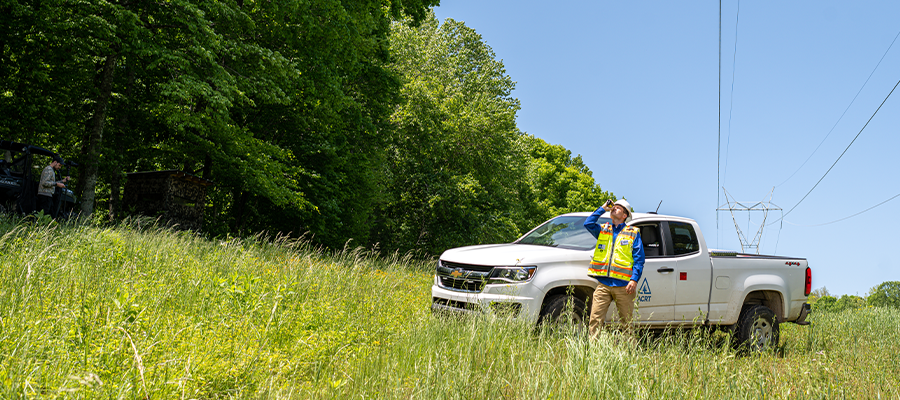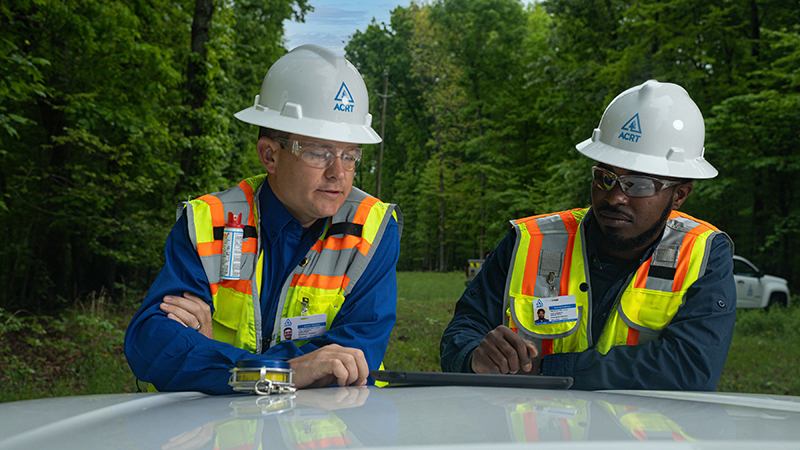- Vegetation Management Services
- Industries
- In Your Neighborhood
- About
- Careers
- Webinars
- Articles
Work Auditing and Utility Foresters in Vegetation Management

Work Auditing and Utility Foresters in Vegetation Management
Effective work planning and auditing are essential components of utility vegetation management (UVM), ensuring the safety, reliability, and efficiency of power delivery systems. Central to these processes is the role of the consulting utility forester (CUF), who bridges the gap between utility companies and vegetation management operations. This article explores the significance of work planning and auditing in UVM, highlighting the contributions of CUFs and the services provided by ACRT, a leader in independent utility vegetation management consulting.

Master Work Planning with CUFs
See how CUFs transform work planning and auditing.
The Importance of Work Planning in UVM
Work planning in UVM involves the systematic identification, inspection, and evaluation of vegetation near utility lines to prevent service interruptions and ensure public safety. Proactive work planning helps utilities address potential hazards before they escalate into costly outages or safety incidents.
The risks associated with poor vegetation management are significant. Overgrown trees and brush can encroach on utility lines, causing outages, fires, and damage to infrastructure. The economic impact of vegetation-related power disruptions in the U.S. is estimated at $20 billion annually, underscoring the critical need for effective planning.
ACRT provides pre-inspection and work planning services that include thorough assessments of vegetation along utility lines and actionable recommendations. Our pre-inspection services ensure utility companies can identify risks early, allowing for effective resource allocation. By integrating advanced technologies such as Geographic Information Systems (GIS) and data analytics, ACRT enhances the precision and efficiency of vegetation management plans. These tools allow utilities to map risk areas, monitor growth patterns, and create data-driven strategies to mitigate hazards.
The Role of Auditing in UVM
Auditing serves as a critical quality control mechanism in UVM, ensuring that vegetation management activities comply with established standards and regulatory requirements. Regular audits identify areas for improvement, verify the effectiveness of maintenance programs, and uphold safety and reliability standards.
Vegetation management audits are particularly valuable in providing utilities with performance insights. These evaluations examine whether work has been completed to specifications, identify gaps, and offer recommendations for improvement. For example, an audit may uncover inefficiencies in tree trimming practices or reveal areas where compliance with safety standards needs reinforcement.
Through comprehensive auditing services, we support utilities in evaluating vegetation management practices, offering insights into compliance status and performance metrics. ACRT’s auditors provide unbiased assessments, ensuring transparency and accountability in utility operations. These audits facilitate continuous improvement, enabling utilities to refine their practices and meet regulatory expectations.
Consulting Utility Foresters: Bridging the Gap
Consulting utility foresters play a pivotal role in UVM by acting as liaisons between utility companies and vegetation management crews. Their responsibilities encompass a wide range of critical tasks:
Identification and Evaluation
CUFs assess trees and brush along utility lines, identifying potential hazards that could lead to outages or safety risks. Their evaluations help prioritize areas that need immediate attention, ensuring that resources are deployed effectively.
Work Planning
CUFs develop detailed work plans for vegetation clearance, specifying which trees and vegetation require trimming or removal. These plans account for safety protocols, environmental regulations, and operational priorities.
Customer Engagement
One of the unique responsibilities of CUFs is their role in customer relations. They communicate with property owners and the public, addressing concerns about vegetation management activities. This engagement fosters cooperation and minimizes conflicts during operations.
Quality Assurance
CUFs also conduct audits of completed work to ensure it meets quality and compliance standards. By verifying that vegetation management crews adhere to established guidelines, CUFs help utilities maintain high operational standards.
ACRT’s CUFs are trained to perform these tasks with a focus on safety, efficiency, and effectiveness. Their expertise ensures that utility companies can rely on skilled professionals to manage vegetation risks while maintaining positive community relations.
Technology’s Role in Enhancing UVM
The integration of technology has transformed UVM, making it more efficient and precise. Tools like GIS mapping, drones, and predictive analytics have become indispensable in both work planning and auditing.
GIS Mapping
GIS allows utilities to create detailed maps of vegetation near power lines. This technology provides a clear visual representation of risk areas, enabling targeted maintenance.
Drones
Drones are increasingly used for aerial inspections, offering a safe and cost-effective way to assess vegetation in hard-to-reach areas. They can capture high-resolution images, monitor growth patterns, and identify potential hazards.
Predictive Analytics
By analyzing historical data and environmental factors, predictive analytics helps utilities anticipate risks such as tree growth or the likelihood of storm damage. This proactive approach minimizes the chances of unexpected disruptions.
ACRT incorporates these technologies into its services, ensuring utilities have access to cutting-edge tools for managing vegetation effectively.
ACRT’s Commitment to Excellence
As an independent national vegetation management consulting firm, we deliver unbiased, high-quality services to support utility operations. Our commitment to safety, continuous training, and technological innovation positions it as a trusted partner for utilities seeking to enhance their UVM programs.
ACRT’s services are designed to meet the unique needs of each client. Whether through pre-inspection, auditing, or CUF placements, we help utilities mitigate risks, ensure compliance, and maintain operational reliability. Our emphasis on training ensures that its personnel are equipped with the latest industry knowledge and certifications, including ISA Certified Arborist credentials and other specialized qualifications.
Conclusion
Work planning and auditing are integral to effective UVM, ensuring the safety and reliability of power systems. CUFs serve as essential links in this process, providing expertise and coordination between utilities and vegetation management operations. ACRT’s comprehensive services in pre-inspection, work planning, and auditing exemplify best practices in the industry, supporting utilities in delivering safe and uninterrupted service to their customers.
With the increasing challenges posed by climate change and the need for resilient infrastructure, proactive vegetation management is more critical than ever. By partnering with experts like ACRT, utilities can navigate these challenges effectively and protect their communities from vegetation-related risks.
For more information on the vegetation management services we offer, visit:
Related Articles

Servant Leadership in Utility Vegetation Management By C. Troy Ross, President, ACRT and ACRT Pacific On a chilly Monday morning, a utility vegetation management crew gathers for their weekly briefing. Instead of launching into instructions, their supervisor begins by asking each team member how they’re doing. One mentions a child’s illness, another shares excitement about[...]
Read More
Turning Vegetation Waste into Opportunity By Aana Agrawal, Sustainability and Resilience Manager, EnviroScience The utility vegetation management (UVM) sector plays a crucial role in ensuring the smooth transmission of power across regions and cities by keeping plant growth under control within the vicinity of transmission and distribution lines. However, unrefined vegetation maintenance practices often focus[...]
Read More
Reflections from Will Nutter Silver Shield Award Recipients By Bob Urban, Senior Manager, ACRT Services In an industry where the stakes are high and every decision can have life-altering consequences, leadership in utility arboriculture isn’t just a managerial function; it’s a calling. Nowhere is this more evident than in the recipients of the Will Nutter[...]
Read More
The Electric Butterfly: Reconnecting with Nature on the Edges By Ryan Meccage, Business Development Manager, ACRT Services In an age dominated by smartphones, constant connectivity, and algorithm-driven content, we’ve never been more digitally immersed. Yet somehow, we’ve also never felt so far removed from the natural world beneath our feet. The urge to step away[...]
Read MoreRecent Posts
- Alex Fields Awarded ACRT Safety Challenge Coin 20th Nov 2025
- Servant Leadership in Utility Vegetation Management 12th Nov 2025
- ACRT Honors Our Veterans 10th Nov 2025
- Anna Davis Awarded Safety Challenge Coin 04th Nov 2025
- ACRT Senior Consulting Utility Forester Recognized as Safety Superstar 15th Oct 2025
Categories
The Leader In Vegetation Management
We are all about people, and we put safety first. Ready to work with our well-trained team?